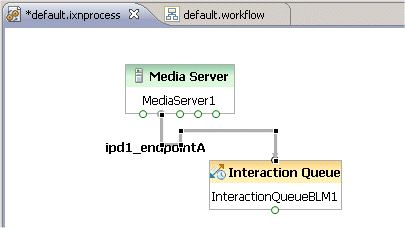Interaction Queue Block
Contents
This block is used only for multimedia workflows.
Use this block to define or select a multimedia (non-voice) interaction queue in an interaction process diagram and to create Views, which defines conditions for pulling interactions out of the queue for submittal to workflows. You can create multiple views per queue, with each view managing submission of an interaction to a separate routing workflow.
The Publishing operation pushes the interaction queue into the Configuration Database. Its definition is stored as a CfgScript object of type Interaction Queue. After defining the queue, you can then place interactions it as follows:
- The interactions can be sent to the queue from a Media Server block.
- Interactions can also be sent to the queue by using the Queue Interaction block in a Workflow. Queues that you defined with the Interaction Queue block appear for selection in the Queue Interaction block.
Notes
- Composer shows one output port per defined view. This allows the user to route interactions coming through this view to a specific workflow.
- For all properties below, no updates to Configuration Server are created until you invoke the Publish operation.
- You cannot reuse an existing interaction queue in the same IPD, but you can use the same interaction queue in different IPDs. For more information, see Linking IPDs with Workflows.
- Composer points Interaction Queue objects directly to EnhancedRoutingScript (ERS) objects. It does not point Interaction QueueView objects to EnhancedRoutingScript objects.
The Interaction Queue block has the following properties:
Name Property
Find this property's details under Common Properties.
Block Notes Property
Click under Value to display the ![]() button. Enter text to describe the block.
button. Enter text to describe the block.
Object Name
A unique Configuration Server Object Name will be created once a Publish operation is executed. No updates to the database are created until you invoke the Publish operation. If no name is specified for the interaction queue, it will default to the currently implemented naming convention of <project name>.<diagram name>.<block name>. Note: If you rename the block after its corresponding CfgScript object is created in Configuration Server, the original published object name in Configuration Server remains unchanged. For more information, see Publishing Updates.
Enabled Property
This property controls whether or not a block contributes code to the application. You may wish to use this property if there is a need to temporarily remove a block during debugging or, for other reasons during development, temporarily disable a block. This saves the effort of having to remove the block and then add it back later.
Existing Queue Property
Use this property to select an existing interaction queue. Any changes made to the queue in the IPD are updated in Configuration Server during the Publish operation.
Queue Description Property
Enter a description of the interaction queue. This property will map to the Description key in the annex section Queue of the CfgScript object for the interaction queue.
Views Property
Use the Views property to define one or more Views for an interaction queue. Composer creates one outport per View. It is mandatory to define at least one view for an interaction queue in an IPD. Background: An interaction queue can have one or more associated Views. Each view represents an exit channel from the interaction queue into a workflow. In Configuration Server, each view will be created as a separate CfgScript object of type InteractionQueueView.
Defining a View
To define a view:
- Click under Value to display the
 button.
button. - Click the
 button to open the View Properties dialog box.
button to open the View Properties dialog box. - Click Add to display Main, Parameterized Conditions, and Segmentation tabs. For information on these tabs, see the Interaction Queue Views topic.
- After you complete the applicable fields in these tabs, click OK to close the View Properties dialog box.
Note: Multiple views are supported on a single queue. This enables certain interactions to be processed earlier than others.
Interaction Queue Definition
Genesys software maintains both interaction and virtual queues.
- A multimedia queue in an interaction process diagram is called an interaction queue. You use Composer's Interaction Queue block to create/configure an interaction queue, which can also be thought of as a persistent queue. Once an interaction queue is configured and activated, multimedia interactions arriving from media servers (Media Server block) can be selected using the Views block property.
- In contrast, all voice interactions arriving from T-Servers are submitted to Universal Routing Server (URS), which places them in virtual queues. A virtual queue is not a physical queue but rather a logical queue to which all voice interactions are queued if the specified targets within a routing workflow are not available.
Deleting Interaction Queues
If you delete an Interaction Queue block from an IPD, Composer does not allow deletion of the Interaction Queue block itself. In this case, you must manually clean up the objects using Genesys Administrator.

